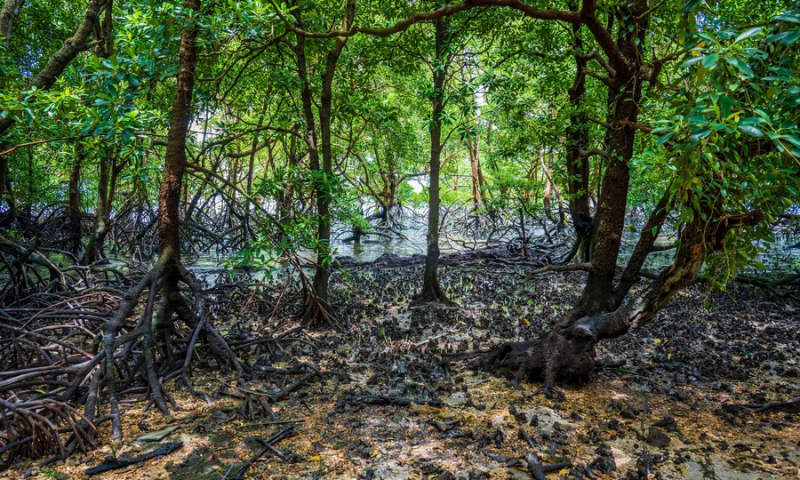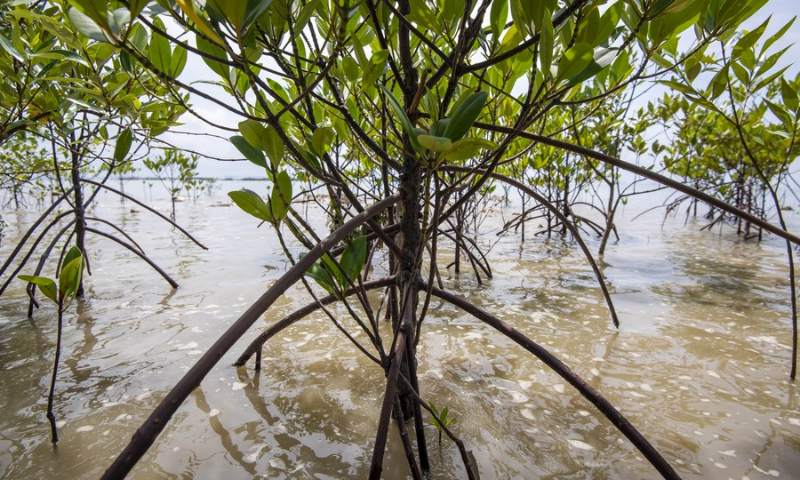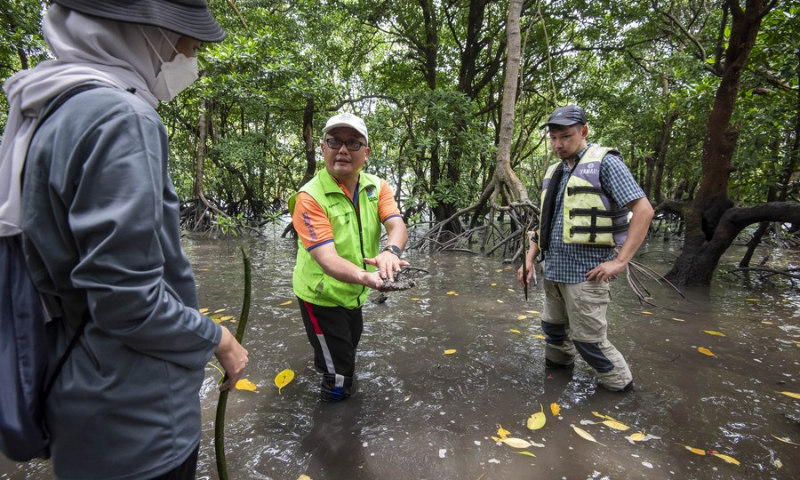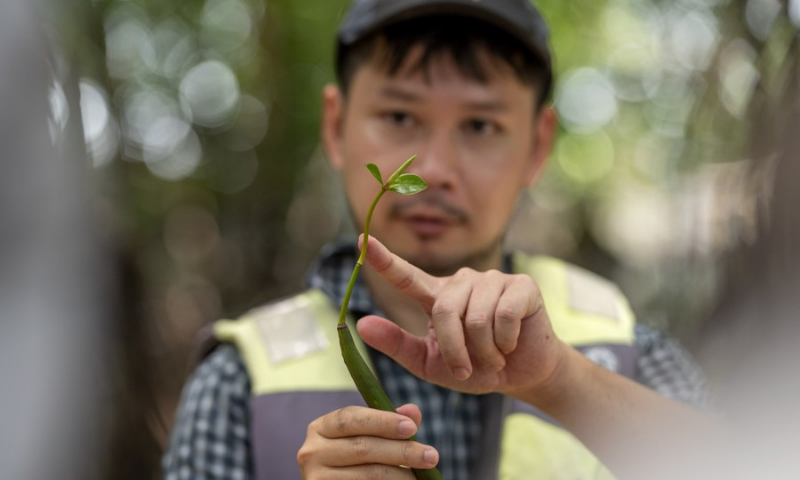
The mangrove swamp is pictured in Pulau Merambong in the state of Johor, Malaysia, April 20, 2022. (Photo: Xinhua)

The mangrove trees are pictured at Tanjung Piai Johor National Park in the state of Johor, Malaysia, April 19, 2022. (Photo: Xinhua)

Richard Chan (C), a local NGO volunteer, talks with Brian Yap (R), lecturer at Tun Hussein Onn University (UTHM) and his student, near the mangrove trees in Pulau Merambong in the state of Johor, Malaysia, April 20, 2022. (Photo: Xinhua)

Brian Yap, lecturer at UTHM, introduces the mangrove sapling in Pulau Merambong in the state of Johor, Malaysia, April 20, 2022. (Photo: Xinhua)
Glittering sea, symphony of waves, warm sunlight, and cool breeze -- everything feels just right on the unmanned island of Pulau Merambong, which is located in Malaysia's southern state of Johor, except, right at the back, trash is strewn along the shoreline.
Plastic bottles, aluminium cans, used product packaging, polystyrene foam boards, worn-out bags, shoes and even helmets can be spotted.
Volunteers cleaning up the beach told Xinhua, "We believe that the garbage is washed up onto this uninhabited island. Well, we once found an abandoned fridge, so helmets are not that surprising."
Even if they are saying it in a joking manner while shrugging resignedly, the unintended disappointment in their eyes could not be hidden, as it is not long after their last clean-up work.
Pulau Merambong is a small island with sandy beaches, rocky coastal area and dominating mangrove swamps.
Besides the island, mangrove forests are seen mainly along the west coast of Peninsular Malaysia, at the estuaries of Sarawak and along the east coast of Sabah.
Mangrove forest is a significant part of the ecosystem that help in protecting coastal areas, especially to lower down the impact of tidal surge and strong wind when tsunami strikes. In addition, it is a natural breeding ground for bountiful marine creatures along the coastal line.
Andik Idris Munabak Bin Andik Burhanudin, wildlife assistant at Tanjung Piai Johor National Park, describes the mangrove forests as a gift from mother Earth.
"The long roots of mangroves serve as natural barriers in trapping the marine debris washing aground. Mangrove forest is also a significant resting site for hundreds of shorebirds and migratory bird species," said Andik.
Richard Chan, a local volunteer who is dedicated to the mangrove conservation, visualizes the mangroves as the lungs to Earth while he tries to explain how important the forest is to children.
"Our lungs do not have active functions to excrete unwanted substances and need help from other organs to do so. So, we, as humans, should act as the kidney, and take up the responsibility in cleaning up our mangrove forests," said Chan.
According to the Global Forest Resources Assessment (FRA) report by the Food and Agriculture Organization (FAO) of the United Nations in 2020, the area of mangroves showed a substantial loss of 1.04 million hectares between 1990 and 2020 globally.
In Malaysia, in particular, the area of mangrove forest decreased from 467,760 to 409,290 hectares in the past 30 years, as per the report from Mohd Ridza bin Awang, deputy director-general of Forestry Peninsular Malaysia (Policy & Planning) to FRA.
Lim Beng Chee, 55, is greatly saddened when he finds out that the mangrove swamp in his memories is now gone.
Born and raised in Pontian district located in the southwest of the state of Johor, which is surrounded by the Straits of Malacca and Singapore, mangrove swamps will always have a special place in Lim's heart.
"I could still vividly remember my friends and I going to the beach for a basketball match after school. Then, we would enjoy the sunset with the companion of mangroves. But now the mangroves are no longer there. I can't help but to feel disheartened when the wave of nostalgia sweeps over me every time," Lim said.
Lim now runs a creative workshop named Xiapism, which makes sustainable handicrafts with the use of mangrove-bark-produced tannin natural dye. Lim wishes to highlight the environmental threats that mangroves are facing through their products, and to promote an alternative product to reduce the use of plastics.
Other than the accumulation of marine debris, land erosion caused by waves and sand sediments from the nearby land reclamation is now a new rising threat to the mangroves.
Dr. Mohd Adib bin Mohammad Razi is an associate professor from Tun Hussein Onn University (UTHM) who majors in hydraulic and hydrology in coastal engineering.
In a recent interview with Xinhua, Adib shared his insights on how the increase of maritime traffic density at Malacca strait is causing land erosion to the nearby mangrove area.
"Malacca strait is one of the busiest waterways in the world, and it is noticeable that since 2003, more and more bigger ships are coming into the strait... From a logical point of view, bigger ships can create bigger waves with higher energy, causing an impact to the coastal area, especially to the nearby mangrove swamps," said Adib.
Xinhua reporters went on a boat trip to Sungai Kemudi (Kemudi river) and the nearby mangrove areas along the south coast of Johor state with the local academicians. It is observable that some roots of the mangroves are hanging and exposed to the air during low tide.
"It is not a good sign ... It means that there used to be mud and soil in the area, but they were being washed away. Something has changed in this area, and that is causing the mangrove forest to disappear," said Dr. Brian Yap, a lecturer at UTHM who majors in plants and genetics.
Brian further explained that an undisturbed mangrove forest should have layers of different species of mangrove according to the zonation pattern.
In his observation, mangrove swamps with close proximity to busy waterways tend to be disturbed with the traits of mixed species growing all together without clear layering, and the one on Pulau Merambong is an example of it.
"To store the mangrove back in place, we have to look into the source of disturbance and what actually is causing the mud to be washed away," he said.
Malaysia's Tanjung Piai Johor National Park has worked with scientists and engineers, including Dr. Adib in creating coastal revetments to slow down the wave energy which is posing threat to the mangrove forest in the park.
Thanks to continuous efforts by local authorities and non-governmental organizations in the plantation of mangrove saplings, the national park is now especially picturesque with different lively shades of greens.
Furthermore, it is worth noticing in the FRA report that the rate of loss in mangrove forest has been halved for the past three decades, from an average of 46,700 hectares per year in 1990s to 21,200 hectares per year in 2020s globally.
"Environmental conservation and economic development should never be two extremes. We can definitely strive for a balance in both, and aim to achieve an ultimate goal of a sustainable environment," said Poh Pai Yik, founder of the Safe Johor River NGO.







